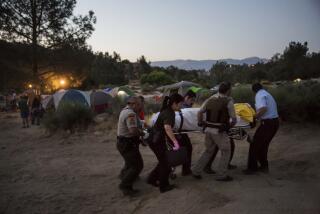Drowning a Leading Cause of Death for Toddlers : Safety: Childhood Injury Prevention Program says eight out of 25 county drowning victims in 1991 were under 4 years old.
- Share via
SANTA ANA — Pool drownings, not car accidents, are the leading cause of accidental death for Orange County’s infants and toddlers, according to a first-of-its-kind report issued by a county agency Monday.
Eight of the 25 Orange County victims of drownings in 1991 were children under age 4, and six of those incidents occurred in pools, according to the report by the Childhood Injury Prevention Program of the County Health Care Agency. The report lists 59 near-drownings for the same age group during the year.
“I think a lot of people aren’t aware that the danger to that age group is this great, and that’s why this report is important,” said Dr. Rick Greenwood, who oversees the year-old program. “It’s a great danger here in Orange County, which is an affluent county with lots of swimming pools. And this is the drowning season.”
Among the 4-and-below age group, more than half of the drownings or near-drownings occurred during the months of June, July or August. That seasonal percentage holds up among other age groups as well, with 57% of all 143 reported cases occurring during that three-month period.
For all age groups, more than half the drownings and near-drownings occurred in swimming pools, followed by 18% in the ocean. After the 4-and-below age group, most incidents involved 5- to 10-year-olds. The report’s coordinator, program manager Amy Dale, said drowning is the third most common cause of accidental death among the 5-10 age group, behind automobile and pedestrian accidents.
Besides statistics, Greenwood said the report yielded some insight into the way the drownings and near-drownings occur among children.
“In most of the deaths involving toddlers, the kids were last seen in the house or somewhere besides the pool area,” Greenwood said. “It’s kids being put down for a nap, and the next time the mother sees them they are face down in the pool.”
In 47% of the incidents documented, the children were last seen inside the house or away from the pool area. In one case, a mother reported her child was in a car sitting in a booster seat before somehow reaching the pool, the report states.
Dr. Hildy Meyers, the report’s epidemiologist, said that because “100% supervision is extremely difficult even for a very careful, responsible adult,” parents should attempt to set up “layers of protection.”
Greenwood said such safety measures include fences that block off the pool from the house, self-latching doors in pool areas and a phone in the pool area. He said parents should also learn cardiopulmonary resuscitation and keep the pool clear of toys that might tempt toddlers.
Greenwood said the report would add strength to his program’s push to get local governments to stiffen ordinances and building codes that might prevent child drownings. “This gives a clearer picture of what’s going on,” he said. “It gives us information we hope to turn into policy.”
Children, Water Equals Danger
Children up to four years accounted for 47% of the drownings or near-drownings in Orange County in 1991. Most of those incidents took place in either a pool or spa, as did seven of the eight deaths.
Drowning, Near-Drowning Sites Pool: 66% Spa: 21% Bathtub: 10% Other: 3%
Pool, Spa Isolation Fences
In only half the pool or spa incidents were fences that isolate the locations present. Fences: 21% No fences: 50% Don’t know: 29%
Gender Differences
In 1991, boys were more likely to be involved than were girls. In 1990, the division was much closer.
1991 1990 Males 64% 53% Females 36% 47%
Source: Orange County Health Care Agency, Childhood Injury Prevention Program
More to Read
Sign up for Essential California
The most important California stories and recommendations in your inbox every morning.
You may occasionally receive promotional content from the Los Angeles Times.













